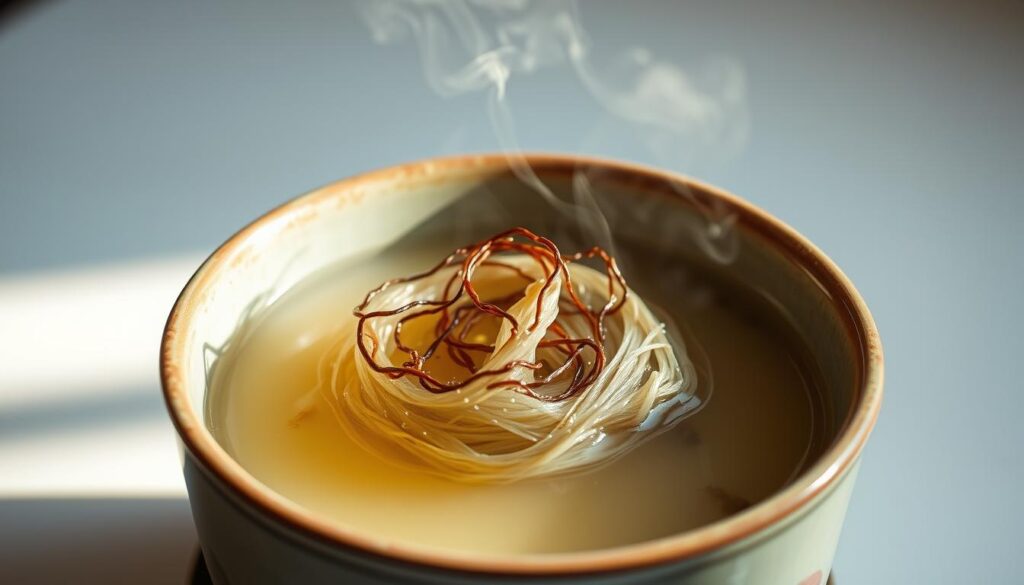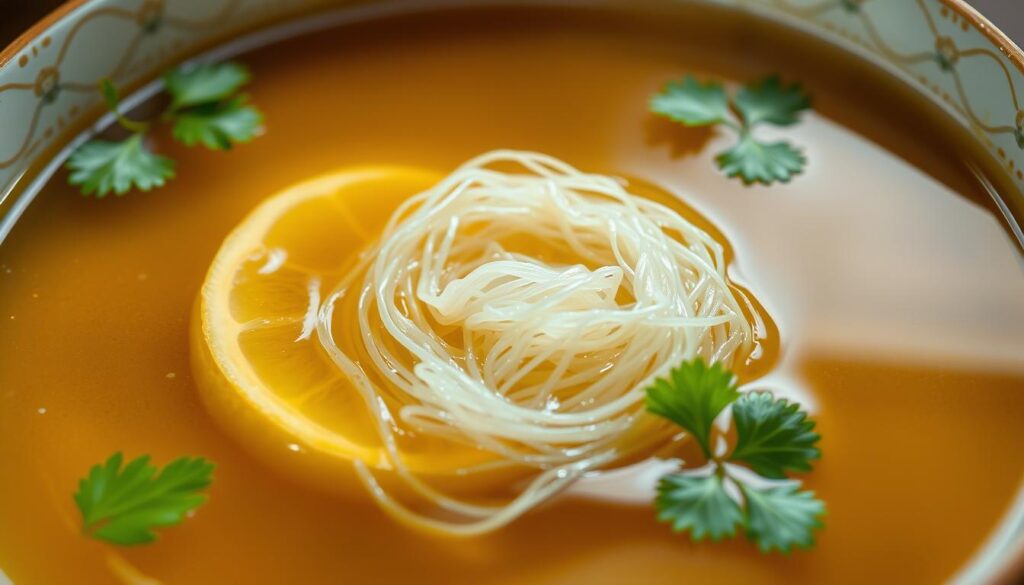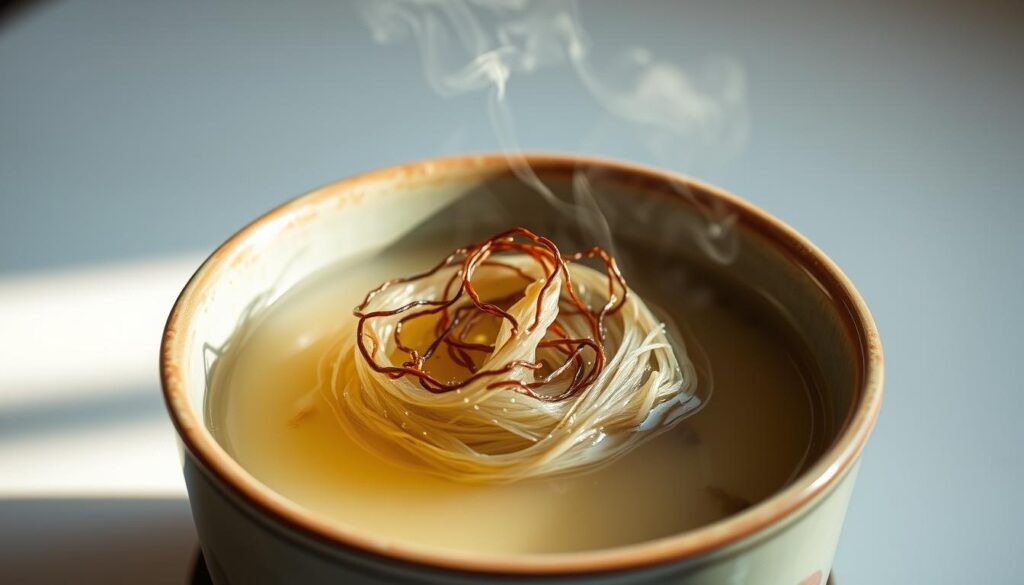
Imagine paying up to $100 for a single bowl of soup. This isn’t just any soup. It’s the world’s most expensive bird’s nest soup. It’s a centuries-old delicacy that fascinates food lovers worldwide.
The nests are made from the solidified saliva of swiftlets. They are harvested from cave walls or special houses in Southeast Asia. This process is rare and dangerous.
The price of this dish is high because of its rarity. Harvesters risk their lives to climb steep cave walls. The best nests can cost up to $10,000 per kilogram, Expensive Bird Nest Soup.
Chinese emperors once loved this soup for its smooth texture and subtle flavor. It’s not just about taste. It holds deep cultural value in Asia, Expensive Bird Nest Soup.
Many believe the soup boosts immunity, improves skin, and even adds to longevity. This ancient luxury is now found in modern fine dining in America. Expensive Bird Nest Soup – More people are willing to pay high prices to try it.
The question is: Is any soup worth this much?
Key Takeaways Expensive Bird Nest Soup
- Bird’s nest soup can cost up to $100 per bowl in restaurants
- The main ingredient is made from the solidified saliva of swiftlets
- Premium quality nests can sell for up to $10,000 per kilogram
- Harvesting involves dangerous climbing of cave walls
- The delicacy has been treasured since imperial Chinese times
- The soup is believed to offer numerous health benefits
- It’s gaining popularity in luxury dining establishments across America
The Ancient Origins of Bird’s Nest Soup
Edible bird’s nest has been a rare treasure in Chinese cuisine since the Tang Dynasty (618-907 AD). These nests are made from the saliva of swiftlet birds. Chinese sailors first found them in coastal caves, Expensive Bird Nest Soup.
The Imperial Chinese History
Chinese emperors saw bird’s nest soup as the ultimate status symbol. Palace kitchens made grand feasts with this delicacy for nobles and guests. The Ming Dynasty used over 1,000 nests each year for the emperor, Expensive Bird Nest Soup.
The Qing Dynasty Emperor Qianlong called bird’s nest soup “the taste of heaven.” He made sure it was at every state banquet.
Cultural Significance Throughout Southeast Asia
This tradition spread to Southeast Asia, with each place having its own way. In Malaysia, bird’s nest soup is served at weddings for good luck. In Indonesia, harvesters do rituals before taking nests from caves. In Vietnam, new mothers are given processed nests as gifts, Expensive Bird Nest Soup.
Traditional Medicinal Uses – Expensive Bird Nest Soup
In traditional Chinese medicine, bird’s nest is prized for its healing. The Ben Cao Gang Mu talks about its power to boost qi and help the lungs. Women ate it to keep their skin young, and the elderly used it to live longer, Expensive Bird Nest Soup.
Today, people believe bird’s nest soup boosts immunity, improves skin, and helps breathing. These old health benefits still attract buyers, who pay high prices for real nests.
What Makes Bird’s Nest Soup The World’s Most Expensive Bird’s Nest Soup
The price of bird’s nest soup is shocking, with raw nests costing between $1,000 and $4,500 per pound. This makes a single bowl over $100 in fancy restaurants. It’s the most expensive dish in luxury Asian cuisine.
The reason for this high price is simple: there’s only a few types of swiftlet birds that make edible nests. These nests are found in remote caves in Southeast Asia, Expensive Bird Nest Soup.
The quality of the nests also affects the price. White nests are standard, but red and gold ones are much pricier because they’re so nutritious. Buyers look at the nest’s shape, cleanliness, where it’s from, and how strong it is.
Nests from caves in Thailand and Indonesia are the best. They’re seen as better than those farmed elsewhere.
There’s not enough supply to meet the demand, especially from rich people in China, Hong Kong, and the U.S. It takes skilled climbers to get these nests from dangerous caves. They risk their lives to do this, Expensive Bird Nest Soup.
This limited supply and the problem of fake nests also raise the price. So, bird’s nest soup remains a rare and expensive treat in luxury Asian cuisine.
In the hierarchy of culinary luxuries, bird’s nest soup stands alongside Italian white truffles ($3,000/pound) and saffron ($5,000/pound) – placing it among the world’s most rarefied dining experiences.
The Harvesting Process: Danger and Dedication
Harvesting swiftlet nests is one of the most dangerous food gathering methods globally. People risk their lives to get these valuable ingredients. They show great dedication to this long-standing tradition.
Cave Harvesting Methods – Expensive Bird Nest Soup
Harvesters use basic bamboo scaffolding to climb limestone cave walls. They climb hundreds of feet in dark, humid caves. They must navigate slippery surfaces and avoid bats.
They have to time their harvest perfectly. They need to know when nests are ready without harming swiftlet breeding cycles.
House Nest Farming – Expensive Bird Nest Soup
A safer method has been developed. It uses special buildings to attract swiftlets. Expensive Bird Nest Soup – These buildings have sound systems that play swiftlet calls.
This method is becoming popular in Southeast Asia. It offers a more controlled environment for harvesting nests. It also reduces the risks for collectors, Expensive Bird Nest Soup.
Ethical Considerations and Sustainability
The bird’s nest harvesting industry is under scrutiny for sustainability. Over-harvesting has harmed some swiftlet populations. This has led to the creation of certification programs and regulations, Expensive Bird Nest Soup.
- Harvest timing restrictions protect breeding seasons
- Government permits limit quantity of nests collected
- Bird-friendly house design standards improve habitat quality
- Fair trade initiatives ensure proper compensation for harvesters
These steps aim to balance economic needs with conservation. The industry supports rural communities. But it needs careful management to protect swiftlet populations and traditions for the future.
Nutritional Profile and Health Benefits
Bird’s nest soup is known for its rich nutrients in Eastern wellness traditions. It’s packed with glycoproteins, especially sialic acid. These compounds are unique and have caught the attention of scientists globally.

- Essential amino acids that support tissue repair
- Calcium and potassium for bone health
- Iron for blood oxygenation
- Antioxidants that combat cellular damage
Studies back up some of bird’s nest soup’s health claims. Food chemistry journals show it has anti-inflammatory effects. This might help with respiratory issues.
It also has epidermal growth factor, which helps skin heal. This supports its use in beauty treatments.
The glycoproteins in bird’s nest have unique properties unlike any other food source, which makes their potential health applications particularly fascinating to researchers.
In Asian cultures, pregnant women and new moms eat bird’s nest soup. It’s thought to boost maternal and infant health. Expensive Bird Nest Soup – The collagen in it is believed to make skin more elastic, which is why it’s used in anti-aging products.
While some benefits are backed by science, others are based on tradition. The mix of old wisdom and new research keeps bird’s nest soup fascinating. It’s a topic of interest for both nutritionists and food lovers.
The Meticulous Preparation Process
Turning raw edible bird’s nest into a luxury dish is a long and detailed process. It takes a lot of patience and skill. From cave wall to soup bowl, every step is carefully done.
Cleaning and Processing Raw Bird’s Nests
The first step in making bird’s nest soup is cleaning the nests. This can take days. Workers use magnification to remove feathers, dirt, and small particles by hand.
Then, the nests are soaked in water to make them soft. This makes it easier to clean them further.
After cleaning, the nests go through soaking cycles with fresh water. The water is changed often until it’s clear. The nests are then shaped and dried in a clean environment. This helps keep their nutrients and prevents contamination.
Traditional Cooking Methods – Expensive Bird Nest Soup
To make bird’s nest soup, the nests are simmered with sugar and water for hours. This makes the nest soft and gelatinous, which is loved by many. Different places add their own special ingredients, like goji berries or pandan leaves.
Nothing compares to the texture of properly prepared bird’s nest soup. The delicate strands should retain their integrity while dissolving slightly on the tongue—a balance achieved only through perfect timing and temperature control.
Modern Culinary Innovations – Expensive Bird Nest Soup
Today, chefs are using bird’s nest in new ways. You can find it in custards, jellies, and even cocktails. Some chefs even add it to ice cream or use it as a garnish for fancy dishes.
But making it at home is challenging. You need to find high-quality nests and follow strict steps. That’s why many people prefer to try it in restaurants where chefs focus on perfecting it.
Experiencing the Flavor: What Does $100 Per Bowl Taste Like?
Many wonder if the luxury of bird’s nest soup is worth its high price. In top restaurants, it costs over $100 per bowl. It’s not just food; it’s a special culinary tradition.
Texture and Taste Profile – Expensive Bird Nest Soup
Bird’s nest soup has a unique texture unlike Western foods. It feels like soft vermicelli but with a natural bounce. The nest has a light sweetness and a hint of minerals.
The taste is soft and sweet, perfect for other flavors to shine. Rock sugar adds sweetness without hiding the nest’s texture. First-timers often find it surprisingly mild, given its luxury status.
Pairing Recommendations – Expensive Bird Nest Soup
Traditional pairings like red dates and goji berries match the soup’s sweetness. Lotus seeds or ginseng add depth and health benefits.
For drinks, choose premium oolong or white tea. They clean your palate between spoonfuls. Fine restaurants serve it in tasting menus, balancing its delicate taste with stronger dishes.
The beauty of bird’s nest lies not in boldness but in its subtle elegance. It demands mindful eating—a moment of pause in our rushed world to appreciate nature’s most delicate offering.
Is it worth the cost? It depends on what you value. If you’re looking for bold flavors, you might be disappointed. But for those who cherish culinary heritage and texture, it’s a memorable experience.
Where to Find Authentic Bird’s Nest Soup in America
Finding real bird’s nest soup in America takes some effort. In San Francisco, Chinatown’s Imperial Palace offers it for $75 per bowl. New York’s Hakkasan has a premium version for $90. Los Angeles’ Sea Harbour Seafood Restaurant adds bird’s nest to their seasonal menus, Expensive Bird Nest Soup.
For making it at home, Asian markets like Wing Hop Fung in Los Angeles and Great Wall Supermarket on the East Coast sell quality nests. Online, Yan Wo House and Golden Nest offer them for $100-$500 per ounce, based on quality.
Expensive Bird Nest Soup – When buying bird’s nest soup ingredients, look for nests that are white or cream-colored with few feathers. Real nests feel fibrous, unlike fakes. Many places need 24-48 hours notice, so call ahead. Bird’s nest soup is more common during Chinese New Year, so January and February are the best times to try it.
Celebrity and Luxury Culture Around Bird’s Nest Consumption
Bird’s nest soup is a key part of luxury Asian cuisine. It attracts the elite from around the world. It’s seen as a sign of wealth, especially for celebrities and the rich who love unique dining experiences.
Famous Enthusiasts – Expensive Bird Nest Soup
Chinese superstar Fan Bingbing says bird’s nest soup keeps her skin looking perfect. She adds it to her beauty routine. Basketball legend Yao Ming loves it too, often ordering it at fancy restaurants for special times.

British chef Gordon Ramsay was amazed by bird’s nest soup’s price and taste. American food lover Anthony Bourdain called it “more about history and tradition than taste.”
Bird’s Nest in Modern Luxury Cuisine
Top spots like Hakkasan and Mr. Chow have updated bird’s nest soup. They make it into fancy dishes that wow their guests. These dishes are part of the expensive Chinese delicacies trend, Expensive Bird Nest Soup.
Luxury hotels in Asia offer bird’s nest on their room service menus. The Peninsula Hong Kong has bird’s nest desserts. The Ritz-Carlton Singapore makes bird’s nest cocktails for special events.
Gifts with premium bird’s nest can cost up to $2,500. This makes them symbols of status for business leaders. Korean beauty brands even put bird’s nest extract in $400 facial serums, making it a luxury item beyond food.
| Modern Luxury Application | Price Range | Celebrity Endorsers |
|---|---|---|
| Beauty Supplements | $150-$600 | Fan Bingbing, Lin Chi-ling |
| Gift Sets | $800-$2,500 | Business executives, Diplomats |
| Restaurant Tasting Menus | $200-$500 per person | Visited by Jackie Chan, Zhang Ziyi |
Conclusion: Expensive Bird Nest Soup
The world’s most expensive bird’s nest soup is a true culinary treasure. It combines ancient tradition, cultural significance, and a detailed production process. The effort to harvest and prepare this rare delicacy is unmatched.
This soup is known for its immune-boosting and anti-aging benefits in traditional Chinese medicine. But, its high price makes many wonder if it’s worth it. Those who try it find a unique texture and flavor that goes beyond a regular soup, Expensive Bird Nest Soup.
The value of bird’s nest soup depends on personal taste. It has moved from a medicinal item to a luxury symbol, captivating the world. Whether you try it or just learn about it, this soup shows the power of tradition and creativity in food.
FAQ
What is bird’s nest soup and why is it so expensive?
Bird’s nest soup is a rare dish made from swiftlet saliva. It’s found in Southeast Asia. The price, from $30 to $100 per bowl, reflects its rarity and the hard work to get it.
What is the history and cultural significance of bird’s nest soup?
This soup has a long history, starting in the Tang Dynasty (618-907 AD) in China. It was prized by emperors for its health benefits. Today, it’s a big part of cultures in Malaysia, Indonesia, Thailand, and Vietnam.
How are bird’s nests harvested and what are the ethical considerations?
Harvesting nests used to be very dangerous, with people climbing high to get them. Now, there are safer “bird houses” to farm nests. But, there are still worries about harming swiftlet populations.
What are the nutritional benefits and health claims associated with bird’s nest soup?
Bird’s nests are packed with nutrients like glycoproteins and antioxidants. They’re believed to boost the immune system and improve skin. But, more research is needed to confirm these claims.
How is bird’s nest soup prepared and what does it taste like?
Making the soup is a detailed process. The nests are cleaned and simmered for hours. It tastes subtly sweet, with a hint of salt, and pairs well with ginger and red dates.
Where can one find authentic bird’s nest soup in the United States?
You can find it in top Chinese and Asian fusion restaurants in big cities. Some shops and online stores sell raw nests for making it at home. But, be careful of fake products.
What is the role of bird’s nest soup in modern luxury culture?
It’s seen as a luxury item, with famous people and celebrities promoting it. High-end places add it to their menus. It’s also a pricey gift in Asian business circles.
Source link
- https://allthatsinteresting.com/birds-nest-soup
- https://en.mui.kitchen/food/The-Exquisite-Birds-Nest-Soup-A-Luxury-of-Chinese-Cuisine-20241027-0021.html
- https://www.businessinsider.com/birds-nest-soup-delicacy-asian-cuisine-culture-so-expensive-2019-2
- https://www.news18.com/lifestyle/birds-nest-soup-is-one-of-most-expensive-dishes-in-the-world-heres-why-9037844.html
- https://www.news18.com/lifestyle/this-asian-bird-saliva-soup-is-one-of-the-worlds-most-expensive-foods-8961126.html
